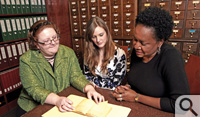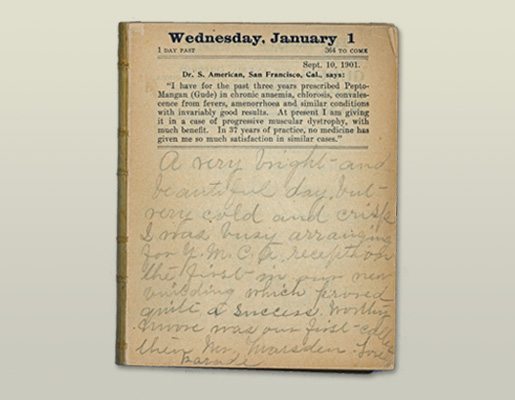The hunt for the mystery diarist
Her penciled entries offer glimpses of the African American middle class in 1902
When a young doctor’s wife wrote in her diary back in 1902, she couldn’t have known that over a century later, scholars at William & Mary would be reading it—let alone trying to determine her identity.
The diary was acquired by the College in 2009 and dwells in Swem Library’s Special Collections Research Center. Its unsigned entries offer a fascinating view into the day-to-day existence of a middle-class African American woman living in Virginia’s Tidewater during the early 20th century. It also provides a focus for hands-on scholarly research, the results of which will surely be of interest to scholars and genealogists—and perhaps some day even to the diarist’s descendants.
 Once Special Collections purchased the diary (on eBay!) University Archivist Amy Schindler placed it on a list of items that would make a good focus for an honors thesis or student paper. Additionally, the diary has a Lemon Project component. Jody Allen, a visiting assistant professor of history and Lemon Project managing director and co-chair, explains the Lemon Project focuses on the history of Williamsburg and the Peninsula from the slavery era through the Jim Crow era.
Once Special Collections purchased the diary (on eBay!) University Archivist Amy Schindler placed it on a list of items that would make a good focus for an honors thesis or student paper. Additionally, the diary has a Lemon Project component. Jody Allen, a visiting assistant professor of history and Lemon Project managing director and co-chair, explains the Lemon Project focuses on the history of Williamsburg and the Peninsula from the slavery era through the Jim Crow era.
“Diary keeping was a common practice in the early 20th century—and certainly not uncommon among African Americans,” Schindler says. “It was probably less common for those of the working class, who would not have had as much leisure time to devote to writing.”
Allen agrees, noting that the diary entries suggest that its author did not work outside the home.
“This gives increased support to the idea that there were, in fact, middle-class blacks during this period,” Allen says.
In spring 2011, Kendra Cabler ’11, seeking a one-credit independent study topic, was the first to look into the diary. She graduated before she was able to make much progress, but her work informed subsequent research.
“I had it in my mind as a project for one of our graduate students,” Schindler says. “Lauren Wallace is working on her master’s in history and she had done some other research for me. So I know that she is very thorough.”
‘A fascinating diary’
Wallace, who also serves as an apprentice in Special Collections, was excited to tackle the project.
“It’s a fascinating diary. The task I was given was to research and check the accuracy of things we thought were true about the diary from Kendra’s research—and ultimately reveal the identity of the diarist,” Wallace explains.
 Wallace set about the painstaking task of scrutinizing clues from the diary and conclusions from Kendra Cabler’s research. She combed through Google Books and other online archives, including special collection research centers in other institutions.
Wallace set about the painstaking task of scrutinizing clues from the diary and conclusions from Kendra Cabler’s research. She combed through Google Books and other online archives, including special collection research centers in other institutions.
“The first thing I did was to begin double-checking dates and events,” says Wallace. “Through Swem’s databases, we have access to many records and newspapers.”
The mystery diarist had written her entries on preprinted, dated pages within a small book called The Physician’s Daily Memorandum, a drug-company freebie. The top half of each page is occupied by day and date information, followed by preprinted segments of a physician’s case notes. The preprinted section for Thursday, July 10, details the gynecological problems of “Mrs. McG., Irish, aged fifty-seven” as recorded by Dr. Geo. G. Van Schaick. In the blank area below, the diarist recorded:
The Hottist day of the season thus far. Mr. Gray shot Dr. Batts and killed him at 8 o’clock at night. It poured down raining.
Wallace plugged events mentioned in the diary into a search engine and newspapers from 1902 began to fill in the blanks. It became clear that the diary was set in Norfolk, not Portsmouth, as was originally believed.
“In one of the entries, she writes of a fire in the Columbia Atlantic Hotel which occurred on January 31,” says Wallace. “The New York Times published an article saying the hotel burned down on January 31, 1902 in Norfolk, Virginia.”
Most entries are less dramatic, mostly logistical ones surrounding church, family and what happened on a given day, e.g., “the weather was hot and Alma cleaned the shed.”
Alma was the diarist’s daughter; her presence in the diary would prove extremely helpful later—as Wallace’s research brought her closer to a positive I.D. of the diarist.
For weeks, Wallace pored over the diary, drawing upon her own research expertise to unlock its mysteries. She knew that the diarist’s husband was involved in a medical association which Wallace theorized was probably the National Medical Association, “since African American doctors were not allowed to be in the American Medical Association in the early 1900s.”
Further inquiry into the National Medical Association revealed a list of prominent physicians in the Norfolk and Portsmouth area. While a number of names were crossed off Wallace’s list because they did not match up to the diary’s doctor, a few proved promising—in particular—a Dr. P. L. Barber.
Wallace was able to call up a document from Howard University, a historically black university, and established that a Philip L. Barber was a medical student there—and the years he was there were consistent with the age of the diarist’s husband.
Zeroing in on the diarist
“Through diary entries, I knew that the doctor’s birthday was in May. At this point, other pieces of the puzzle were falling into place,” Wallace says.
In addition to serving as a local officer for the Norfolk area in the NMA, the diary’s doctor was also involved in the Tidewater Medical Society which provided medical care for the black population in Norfolk.
Ultimately, Wallace located a genealogy site recommended to her by the Norfolk Public Library.
“It showed that Philip L. Barber had a wife named Florence and an adopted daughter named Alma,” says Wallace.
That information prompted Wallace to explore census records for Norfolk, Virginia, where she found pay dirt.
“Throughout the diary, there are references to meetings of the Colored Men’s Department of the YMCA, conferences intended for racial empowerment and equality, and mentions of key individuals in the National Medical Association and Tidewater Medical Society,” she says. “By using these organizations as a framework, it was possible to ascertain that the probable owner of the diary was indeed Florence Barber, wife of Dr. Philip L. Barber.”
Beyond unveiling the probable identity of the diarist, there may be other opportunities for other scholars to build on Wallace’s research. It is clear from diary entries that the doctor and his wife were very involved in their community and that they engaged regularly with influential people of color.
Stirrings of a movement
“I believe that a number of these conferences she wrote about as having attended were important because, although the Civil Rights Movement hadn’t happened yet, there were the beginnings or stirrings of the African American community asserting themselves by trying to better their own lives,” Wallace says.
In the near term, she has completed her research. Her paper will be incorporated into the Special Collections Research Center database so that people who find a description of the diary there will have more background information about the woman and the contents of her diary.
But it doesn’t have to end there.
“I’ve started the ball rolling and now maybe the things that I discovered will make people want to learn more about Florence Barber,” says Wallace. ![]()















